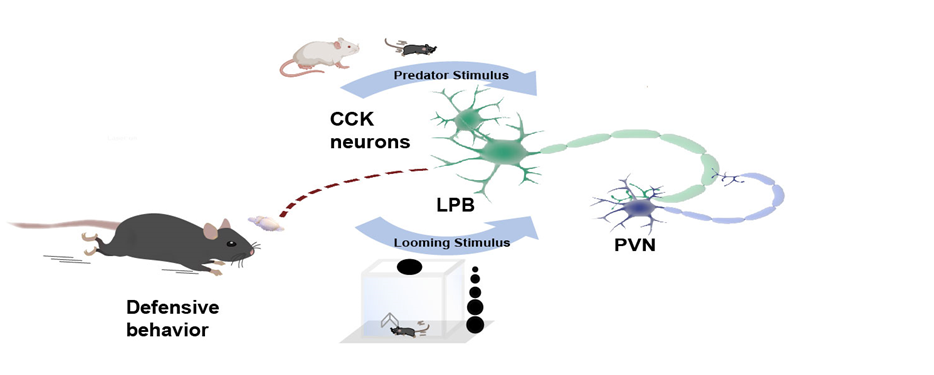Zhihua Gao's group published in eLife on defensive behavior
The research team led by Prof. Zhihua Gao has recently published an article titled A parabrachial to hypothalamic pathway mediates defensive behavior in eLife on Mar 17th, Beijing time. This research identifies a previously unrecognized role for the LPBCCK-PVN pathway in controlling defensive behaviors.
It is the nature of animals to seek profit and avoid harm. In different environments, animals may adopt different defensive behaviors when they encounter threats. Both the paraventricular nucleus of the hypothalamus (PVN) and the parabrachial nucleus (PBN) have been shown to be involved in defensive behaviors. However, whether there are direct connections between them to mediate defensive behaviors remains unclear. Here, by retrograde and anterograde tracing, we uncover that cholecystokinin (CCK)-expressing neurons in the lateral PBN (LPBCCK) directly project to the PVN. LPB is known to be an important relay station in the nociceptive pathway and may function as an alarming center. By in vivo fiber photometry recording, we found that LPBCCK neurons actively respond to various threat stimuli. Selective photoactivation of LPBCCK neurons promotes aversion and defensive behaviors. Conversely, photoinhibition of LPBCCK neurons attenuates rat or looming stimuli-induced flight responses. Optogenetic activation of LPBCCK axon terminals within the PVN or PVN glutamatergic neurons promote defensive behaviors. Whereas chemogenetic and pharmacological inhibition of local PVN neurons prevent LPBCCK-PVN pathway activation-driven flight responses. These data suggest that LPBCCK neurons recruit downstream PVN neurons to actively engage in flight responses.
Prof. Zhihua Gao from Zhejiang University School of Medicine is the main corresponding author. Pro. Shumin Duan from Zhejiang University School of Medicine is co-corresponding author. Dr. Fan Wang and Yuge Chen are the first authors. This work was supported by STI2030-MajorProjects, the Leading talents in Science and Technology of Zhejiang Province, the National Natural Science Foundation of China, the NSFC-Guangdong Joint Fund, the Zhejiang Major Science and Technology Project, the Research Units for Emotion and Emotion Disorders, Chinese Acedemy of Medical Sciences, the Key Area Research and Development Program of Guangdong Povince.








